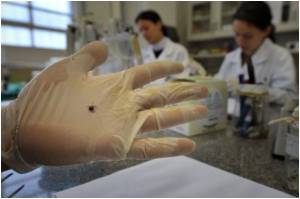Use of antibiotics was found to be productive in treating Lyme arthritis, according to a paper in the Journal of the American Academy of Orthopaedic Surgeons .

Lyme arthritis can be defined as a painful, swollen joint, that causes a stiffness similar to osteoarthritis, and occurs most commonly in the late stages of Lyme disease, usually several months after the onset of the disease. About 60 percent of patients who are left untreated for Lyme disease in its early stages will develop Lyme arthritis, Dr. Cruz said.
"Lyme arthritis occurs when the spirochete, the bacteria that causes the disease, invades the joints and causes inflammation to the tissue that lines the joints," he said. "If left untreated, this inflammatory response can cause the cartilage within the joints to become damaged."
Dr. Cruz said most cases of Lyme arthritis are brief and involve a single joint, most typically the knee. The ankle, elbow, hip and wrist may also be affected, and some patients may develop a fever. Following an initial period of joint pain and swelling lasting from a week to several months, symptoms may recur until the disease is diagnosed. In the acute and late stages, Lyme disease may be difficult to distinguish from other disease processes, he added.
"Diagnosing Lyme arthritis can be problematic, especially in patients who do not report a rash and who have fever, since it can be confused with a bacterial joint infection, particularly in children," Dr. Cruz said. "In general, the diagnosis is multifaceted and involves a thorough understanding of the common clinical and epidemiologic features of the disease, along with careful understanding of the tests used in diagnosis."
"In most patients, Lyme arthritis can be successfully treated with oral antibiotics," Dr. Cruz said. "Nonsteroidal anti-inflammatory drugs may also be given to help manage symptoms while the patient is improving." A small number of patients may continue to have symptoms even after treatment with antibiotics, Dr. Cruz said. In these patients, surgical treatment may be needed to remove the diseased synovial tissue.
Advertisement
- Rash which develops near an insect bite on the skin
- Aching, redness or swelling in one or more joints especially the knee
- Fever
- Lethargy or malaise
- Headache
Dr. Cruz said that although rash occurs in the majority of patients exposed to the Lyme bacteria, in many patients who develop Lyme arthritis, the rash either never develops or goes unnoticed.
Advertisement
Patients who suspect they may have been exposed to ticks carrying Lyme disease should speak to their physicians about the tests used to determine if Lyme disease is present, he said.
"Lyme arthritis has an excellent prognosis with appropriate treatment," Dr. Cruz said. "Most patients respond well to a single course of antibiotics. The key is to diagnose Lyme disease early to avoid development of arthritis, and to differentiate between Lyme arthritis and other types of arthritis in symptomatic patients."
More about Lyme disease:
According to the Centers for Disease Control (CDC), about 30,000 cases of Lyme disease were confirmed in 2009. It occurs most commonly in the Northeast, the Great Lakes region of the Midwest and in the Pacific Northwest. To help prevent Lyme disease and associated arthritis, the CDC recommends the following steps:
- Avoid wooded or bushy areas with lots of leaf litter and high grass
- Take extra precautions during May, June and July when ticks are most active
- Use insect repellent with 20 percent - 30 percent DEET on exposed skin and clothing
- Wear long pants, long sleeves, and long socks to keep ticks off your skin. Tuck pants into boots or socks and wear light-colored clothing so ticks are easier to spot
- Check your skin and clothes for ticks before going indoors
Source-Eurekalert














